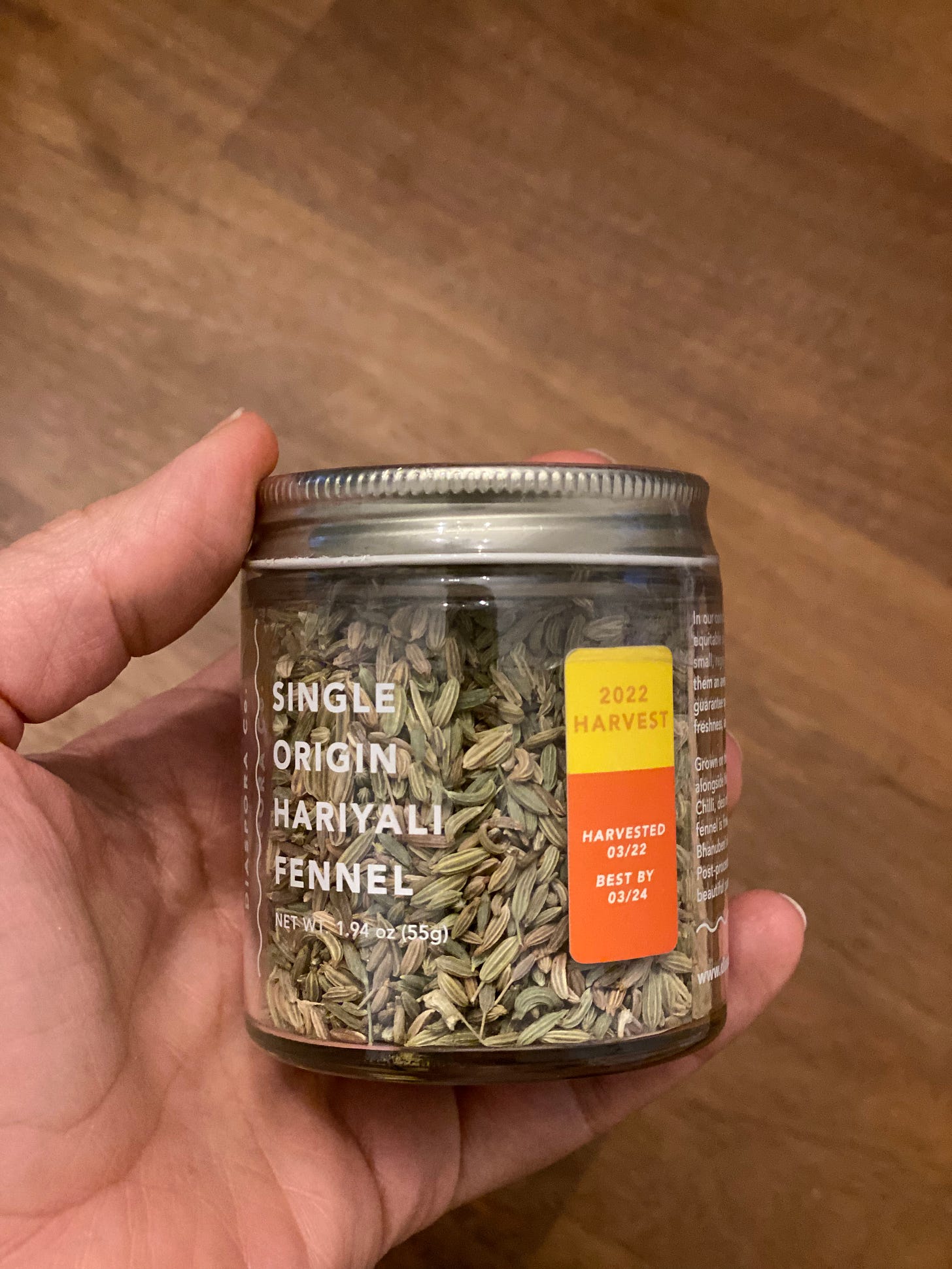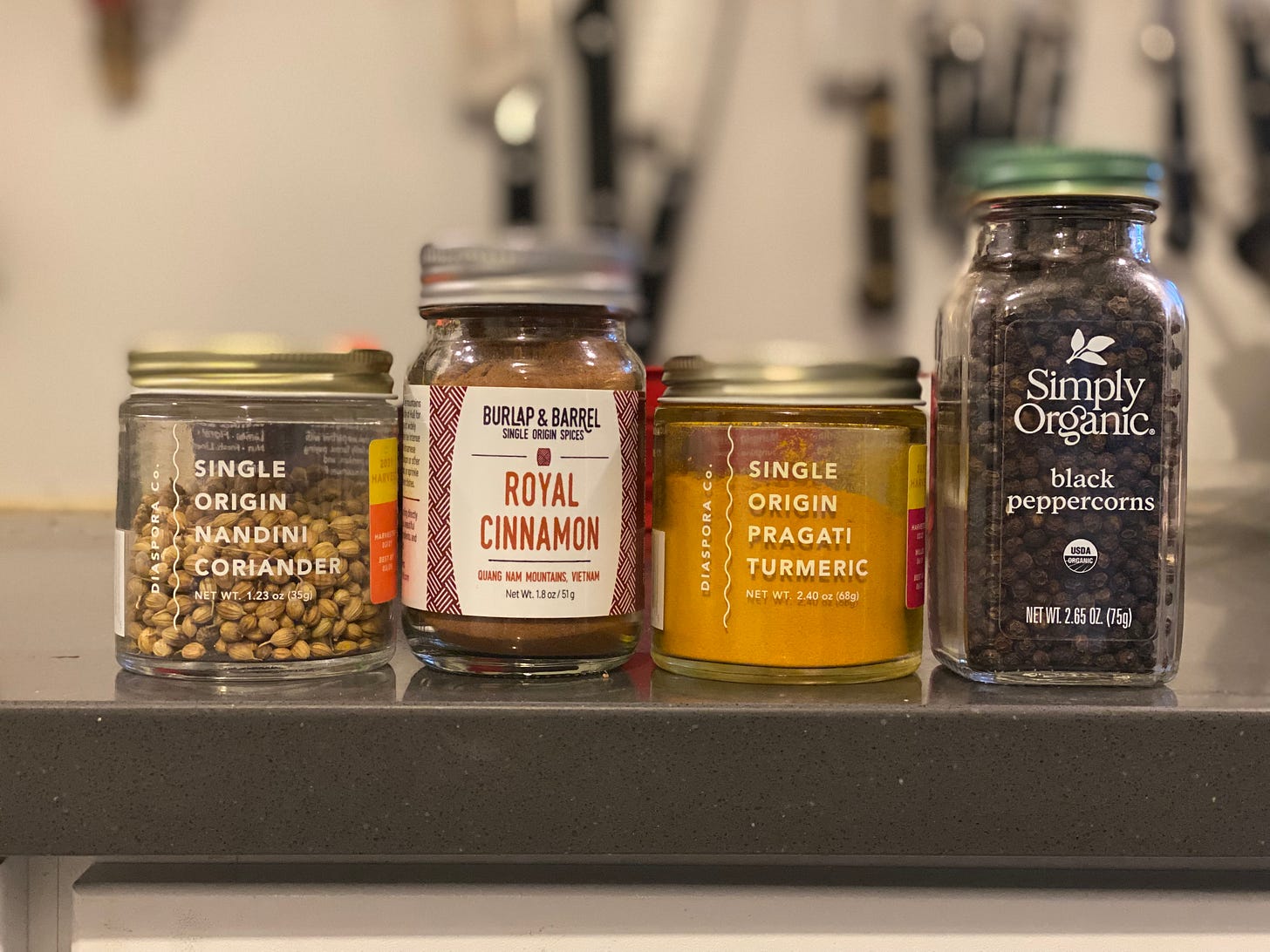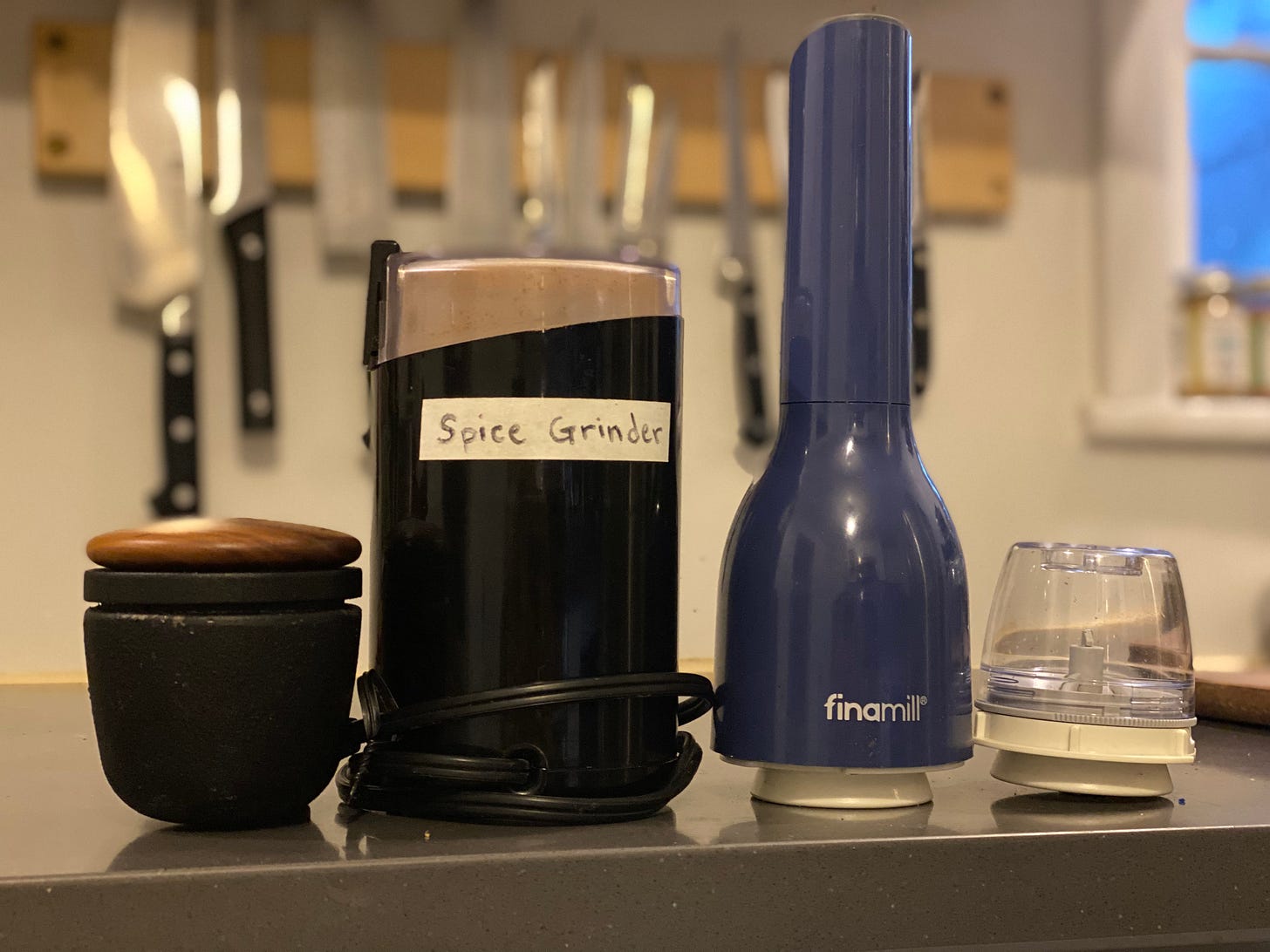fftf: quick guide to improve your SPICE life
why, where, and how I buy & treat my spices, for maximum flavor
“I was wondering where you get your spices…? Eager to jazz up our flavor game.”
I got this text from a new friend in Pittsburgh recently, and realized a newsletter dedicated to answering this question would have been better than the many text messages I sent in reply! So, today - a deep dive into my personal opinions and habits around spices…
the #1 thing = freshness
THE most important way to ensure maximum flavor from your spices is to buy & keep them as FRESH as possible. If you have ground spices that have been sitting around for 3-5 years in your pantry… they probably aren’t gonna do much for your food. (That said, “best by” dates are always up for interpretation, if you ask me - so you should use your nose/gut to judge, always!)
Sadly, spice waste is often hard to avoid, as we all sometimes buy a jar of an obscure spice for one recipe, and then never use it again (and then probably keep picking it up, thinking “not sure when I’ll use this…” but then feeling too guilty to throw it away. Anyone else? 🙋♀️🙋♀️🙋♀️) - hence the pantry full of years-old spices. However, I’d say that an overloaded spice shelf might cause more trouble than it’s worth - if you can’t easily find your spices and/or don’t know what you have - it will be that much harder to actually use them up.
But how fresh are spices bought at the grocery store, anyways?! The truth is - it’s usually impossible to know. They have a “best by” date, but you really have no idea how long it’s taken that spice to get to you, between harvest/processing/transit, etc. Because of this lack of transparency, two new spice companies (Diaspora Co and Burlap & Barrel) have come on the scene in recent years, aiming to better support small farmers, improve flavor/freshness with “single origin” spices, and simplify the supply chain. Most of the food writers/chefs I follow often mention these two companies, and I also buy from them myself.
There’s a lot to say about spices, so to make this guide as usable as possible, I’ve organized it into three sections. First, actions to improve your spice life. Second, recommended spice sources for when it’s time to buy new ones. And third, the specifics on my personal favorite individual spices, specifically which “single origin” ones I’ve found to be really worth it versus not.
Action steps to improve your spice life:
Take stock of what you have right now… clean out/organize that spice rack/shelf/drawer! (also writing this to myself, as I really need to do this!)
Keep spices well organized (as much as you can, ideally all in one place); get rid of/repurpose old stuff and clear out the clutter, BUT…
For very old spices, before you throw them away - check to see if you can repurpose anything! I found these two articles with many ideas! (Hint - natural food dyes, potpourri, DIY gifts!, natural bug repellants). Also - old spices won’t hurt you, so - as long as they’re not moldy, of course - feel free to cook with them and just see how they taste before tossing!
If you don’t know what spices you use most often, consider labeling new spices with the purchase date so you can see how slowly or quickly you go through them. (I use white artists tape and a sharpie for all my food labeling.)
For spices you know you use most often, consider trying out an “upgrade” (see my specific favorites below), and see if you notice a flavor difference in your cooking.
Search for a local spice shop (or a store with bulk bin spices) in your area, and shop there for smaller quantities of new/obscure spices you’d like to try.
Consider buying whole spices and grinding them yourself as needed. (Whole spices last longer than ground.) See more about my spice grinders below.

Where to buy spices:
Obviously if you need a spice for dinner tonight, you’ll probably grab it at the grocery store. Of course we all do this, and these spices are fine. Though I increasingly try to buy “better” spices from the top two sources below, when I do shop at a standard grocery store, I try to make sure it’s a well-trafficked store (this means it probably has higher turnover of products), and I’ll often stick to more commonly used spices (ground cumin, black peppercorns, etc), as these two factors will hopefully ensure those spices are fresher. A star below indicates it’s one of my favorite places to shop for spices.
Diaspora Co* (online ordering) - I love everything about this company, as you probably know since I mention them all the time!
Burlap & Barrel* (online ordering) - newly finding some favorites here, especially when Diaspora is between harvests/sold out, lol
Mountain Rose Herbs (online ordering + retail shop in Eugene, OR) - I haven’t actually shopped here but just remembered hearing about them as I was writing this, and I was impressed with the info on their website, so - would try!
support your local specialty spice shop! - I hope you have one and I hope it’s doing well!
my fav local shops, Bay Area (I used to shop at all of these)
Rainbow Grocery in SF* - fabulous bulk spices / everything bulk and it’s super fresh! - bring your own tiny jars for new discoveries!
Oaktown Spice Shop* - locations in Oakland, Albany, and SF (wow, they have two new locations! I love to see it!); you can also order online, which I might have to do now as their product variety is extremely impressive
Good Earth Natural Foods, in Mill Valley & Fairfax
Berkeley Bowl in Berkeley
local shops in Pittsburgh, PA
Penzeys, which is also a national chain with stores across the US - I haven’t personally shopped here yet, so not necessarily recommending this, but it seems to be the only spice shop in Pittsburgh. I’ll need to check it out and evaluate. If anyone has hot Pittsburgh spice tips, please let me know!
Specifics - my personal favorite spices and the tools I use:
These are either my most commonly used spices OR ones on which I have a hot take that feels worth sharing. As the spices from Diaspora Co and Burlap & Barrel are probably at least double the price of grocery store spices, I’d really recommend that you only “upgrade” for spices that you know you go through quickly!
black pepper - I buy whole peppercorns and grind fresh, always. Truthfully, I’ve tried the more expensive ones from the single origin companies above, but I can’t really distinguish a difference from grocery store ones 🤷♀️. Since I use these daily, I’ve decided to stick to the grocery store ones for now since it’s more economical.
cinnamon - probably my #1 used spice after pepper - I keep both ground cinnamon and cinnamon sticks around (mainly for cold elixir!); currently loving Burlap & Barrel’s ground Royal Cinnamon and Diaspora’s Wild Cinnamon Quills, but I love trying new kinds, as there’s actually a lot of variety in cinnamon! This is a great one to check out at a local spice shop so you can smell the different varieties. I also find grocery store cinnamon to be pretty decent (probably bc it’s a popular spice)!
turmeric - I’m a diehard fan of Diaspora Co’s pragati turmeric, their original and first product. To me, it is noticeably more flavorful than any other turmeric. I use a lot of turmeric, so I keep this one well-stocked.
whole coriander seeds - also one of my personal favorite spices. Diaspora Co’s nandini coriander seeds are a standout. I also always keep these on hand because they are so flavorful.
crushed red peppers / my all-purpose chili flakes - this collab from Burlap & Barrel plus pizza shop Razza is a newer discovery of mine that I’m currently obsessed with. (They were recently out of stock and I was so sad! Luckily it’s back in stock now and I just ordered two!) It’s a blend of chili flakes that I find super flavorful and just perfectly balanced as a go-to chili flake for both cooking and topping. I like the grind size too - no pepper seeds! - so it blends in really well and also looks gorgeous.
nutmeg - my biggest tip on nutmeg is to buy it whole and grind it fresh per recipe using a microplane. I’ve always done this and I swear whole nutmeg actually does last years; it still always smells soooooooo fragrant and delicious when you grate it freshly. (Currently using Diaspora’s whole nutmeg… which I just discovered my jar is a Sept 2020 harvest and actually has an expired best by date of 2/2022, but it actually comes in the shell, which also helps keep it fresher longer. I just opened the jar and it still smells fab. You best believe I will be using this up, with confidence!)
allspice, cloves, cardamom - I don’t bake a ton, so I buy these whole in small quantities and grind fresh when I do bake with them.
chaat masala - I love trying new spice blends, but this is an area where I sometimes go crazy and then don’t actually use them as much as I thought I would. Chaat masala is one blend that always keep on hand, AND I’ve found there’s also a wide variety of tastes because everyone makes it differently. So far, Diaspora Co’s is my fav. I love it on avocado toast.
whole cumin seeds - I use a lot of these. Truthfully, haven’t noticed a super big difference between the fancier ones and grocery store ones, so currently still experimenting.
ground cumin and coriander - I use these a lot too, and am just realizing as I write this guide that I should really be grinding these fresh for myself, since I always have whole seeds at home! Don’t know why I haven’t thought of this, as I find ground cumin and ground coriander to usually be “just ok.” Speaking of grinders…
I have three different spice grinders that I currently use, although I don’t necessarily recommend any of them (haha) - it depends what you’re doing…
by hand, cast iron spice grinder - I got this cast iron spice grinder as a gift. I definitely wouldn’t call this a “required” item in my kitchen, as I use it relatively infrequently, but I do use it occasionally, and it could be a nice gift for the right person. It’s basically a hand grinder for whole spices. It works well because the cast iron is so heavy, it helps you grind a small amount of spices by hand pretty quickly. I use this when I am grinding a) a small amount and want to be quick/simple about it, b) when a coarse grind works well, and c) generally with savory spices that I’m using in a sauté or eggs or something - usually I use this for whole coriander and cumin. I keep it in my extra spice cabinet next to the stove, and it’s great for getting some of that fresh-grind aroma/flavor without having to pull out/dirty the big spice grinder. Pro-tip, you need to use a little (unused, dedicated!) paintbrush to clean it out/get out all the last ground bits. Instead of buying this cast iron grinder, you could use a mortar & pestle for the same function as well, but it would take a bit more effort/pounding and probably make more of a mess with whole spices flying out everywhere.
larger, motorized spice grinder - since upgrading my coffee grinder, I now use this Krups grinder exclusively for spices. This works well for grinding whole spices into a fine powder OR if making a custom blended spice mix. Truthfully it’s annoying to clean and also annoying to get all the spices out of it, so if I was buying one just for spices, I’d probably try something like this instead - I think the detachable cup would be easier to dump out and clean.
Finamill pepper + spice grinder - while writing this, I realized that I have a third grinder, lol. My previous battery-powered pepper grinder died last year, so I requested the Finamill last Christmas as a replacement. I’ve been using it as a dedicated pepper grinder ever since, which I keep right by the stove. It does a great job on pepper. However, the Finamill’s claim to fame is that you can grind multiple spices without needing to clean every time, because separate “pods” hold the spices, and you can easily pods swap in and out. I just realized I can only remember trying my second pod one other time with another spice… ok, tested it again with some whole coriander just now, which it claims it can grind. It does grind it, but not into a powder, it's more like chards, lol - similar to what my cast-iron grinder would do, except that one also gives you some powder from the crushing action. So - maybe this extra pod is good for salt or multiple types of pepper you want to keep separate, or something like that, but I don’t think it lives up to its claim of “grinding” other spices - because (except for pepper/salt), when I think “ground” spices, I think of a powder, and this does not turn spices into fine powders immediately.
Ok - I hope you enjoyed this spice deep dive! If you have other spice questions, I’d love to hear them - just reply and let me know :)
love,
Jess
Sometimes the text above may include affiliate links, meaning (at no additional cost to you) I get a very small commission if you click through and make a purchase. Truthfully, I am increasingly wary of other people using affiliate links when making recommendations. However, I’m not currently charging for this newsletter, and so - especially if I’m going to link a product anyways, I feel like I might as well get a tiny cut if you decide to buy something. I take recommending things extremely seriously, and am always upfront about things I actually recommend versus just what I’m currently using, but I also want to include links so you don’t have to go searching for things if you do want to check it out. Currently, my only affiliate links are those with Amazon, because honestly - it’s the easiest to set up an affiliate account, and - though I don’t love this reality - often the most convenient way to buy stuff. I’m sure my approach and thoughts on affiliate links will continue to evolve as this newsletter does, and I will keep you posted. Just wanted to be transparent about what I’m currently doing!







